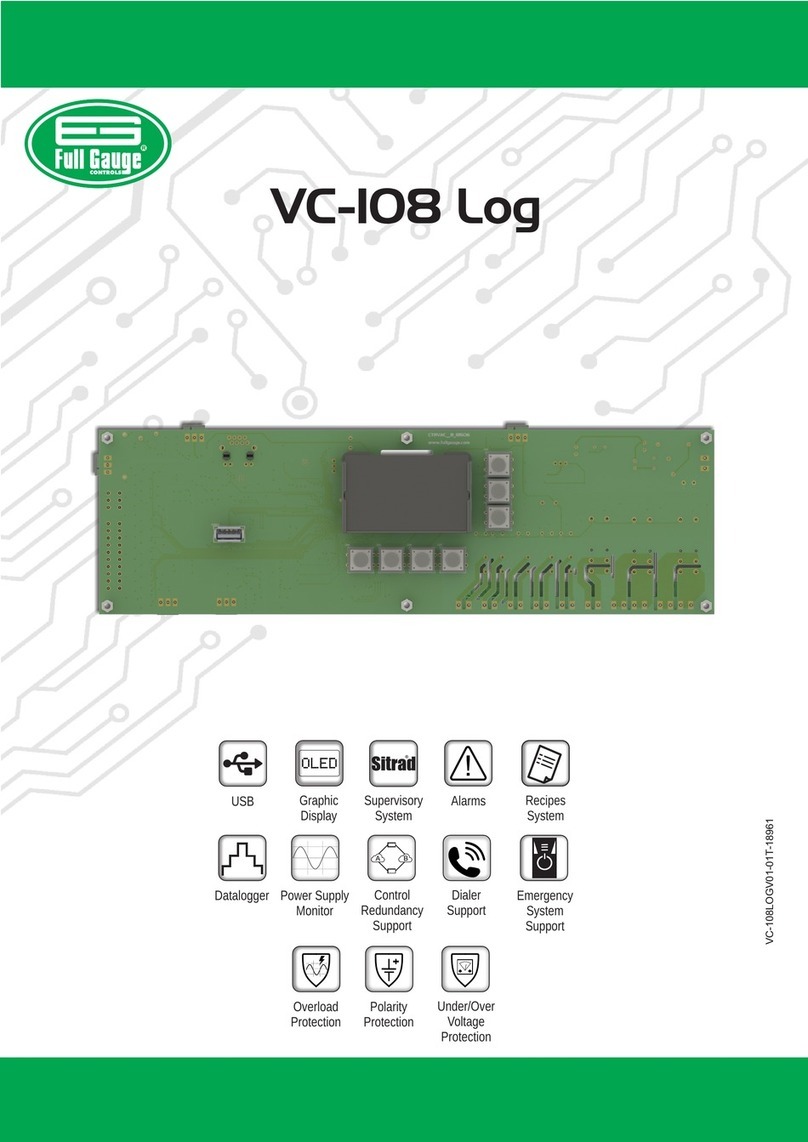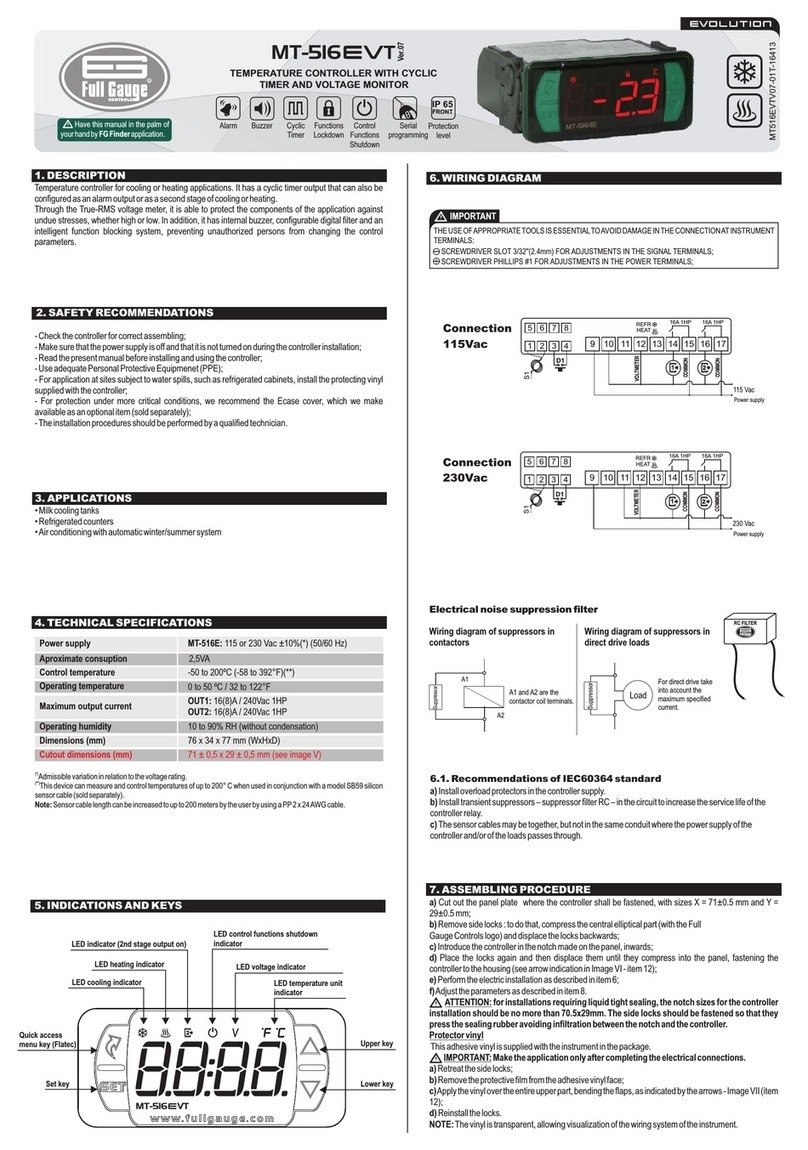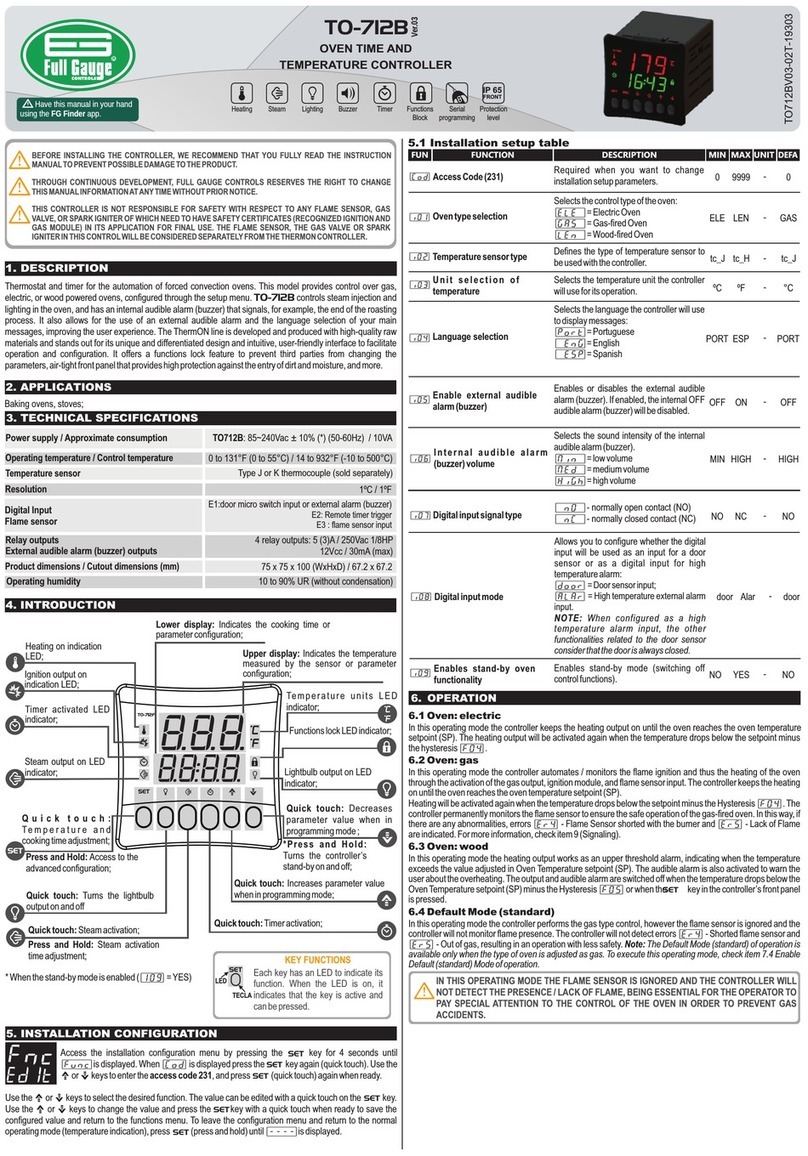8.5. Parameters table F06 - Thermostat 1 output minimum time off:
This is the minimum time during which the OUT1 output remains off, i.e., the time interval between the last
stop and next start. It helps to relieve the discharge pressure and increase the lifespan of the compressor.
This delay also occurs when starting up the device. In facilities with several instruments, assigning different
values to the delay time at the start up of each device will allow for demand peaks to be avoided when the
devices are activated at different times.
If the cyclic timer of thermostat 1 is enabled, this time will not be observed.
This function can be switched off by setting it at the minimum value 0 [no,,].
F07 - Delay of thermostat 1 when the instrument is powered on (initial delay):
Time thermostat 1 will wait before activating its control functions. During this time only the temperature is
measured.
This function can be switched off by setting it at the minimum value 0 [,,no].
F08 - Thermostat 1 cyclic mode operation mode:
Allows configuring the cyclic timer associated to output OUT1:
[Off,] - Disabled: Output OUT1 will be constantly on or off depending only on the temperature.
The possible settings for output time on and output time off are, respectively:
[,,,1] - Seconds/Seconds
[,,,2] - Seconds/Minutes
[,,,3] - Minutes/Seconds
[,,,4] - Minutes/Minutes
For configurations 1, 2, 3, and 4, output OUT1 will keep cycling while the temperature of thermostat 1
requires the output to be on. The initial state of OUT1 is always on.
F09 - Thermostat 1 cyclic timer off time:
F10 - Thermostat 1 cyclic timer on time:
Functions [,F09] and [,F10] are used when the user configures OUT1 as cyclic timer, observing the
time base configured in [,F08].
F11 - Sensor 1 indication displacement (Offset):
Enables compensation for any temperature deviations resulting from sensor replacement or change in the
cable length.
F12 - Thermostat 1 alarm indication mode:
Selects how the thermostat 1 checks for the presence of an alarm. Enabling this function only enables the
alarm indication on the display. If you need the alarm output to be activated, you must configure function
[,F30].
[Off,]- Alarm off.
[,,,1]- In-range alarm ([,F13] and [,F14]).
[,,,2]- Out-of-range alarm ([,F13] and [,F14]).
[,,,3]- In-range alarm related to the setpoint ([SP1,] - [,F13] and [SP1,] + [,F14]).
[,,,4]- Out-of-range alarm related to the setpoint ([SP1,] - [,F13] and [SP1,] + [,F14]).
F13 - Thermostat 1 alarm minimum value:
F14 - Thermostat 1 alarm maximum value:
These are the minimum and maximum values for the alarm to actuate if configured in [,F12].
F15 - Thermostat 1 alarm delay when powering on:
The time that the alarm of thermostat 1 will remain off even in alarm conditions.
This time is counted after the time configured in [,F07] has elapsed.
This function can be disabled by adjusting it to the minimum value [no,,].
F16 - Thermostat 2 operation mode:
Selects the 2nd thermostat operation mode (OUT2):
[Off,] - Off: In this mode, temperature sensor 2 can be disconnected. If function F22 is other than
[Off,], output OUT2 will work only as cyclic timer
[,,,1] - Cooling
[,,,2] - Heating
F17 - Thermostat 2 control differential (Hysteresis):
This is the temperature difference (hysteresis) between turning the cooling (or heating) ON and OFF of
the thermostat.
F18 - Minimum setpoint allowed to user (thermostat 2):
Prevents accidental setting of extremely low setpoint temperatures.
F19 - Maximum setpoint allowed to user (thermostat 2):
Prevents accidental setting of extremely high setpoint temperatures.
F20 - Thermostat 2 output minimum time off:
This is the minimum time during which the OUT2 output remains off, i.e., the time interval between the last
stop and next start.
If the cyclic timer of thermostat 2 is enabled, this time will not be observed.
This function can be switched off by setting it at the minimum value 0 [no,,].
F21 - Delay of thermostat 2 when the instrument is powered on (initial delay):
Time thermostat 2 will wait before activating its control functions. During this time only the temperature is
measured.
This function can be switched off by setting it at the minimum value 0 [,,no].
F22 - Thermostat 2 cyclic mode operation mode:
Allows configuring the cyclic timer associated to output OUT2:
[Off,] - Disabled: Output OUT2 will be constantly on or off depending only on the temperature.
The possible settings for output time on and output time off are, respectively:
[,,,1] - Seconds/Seconds
[,,,2] - Seconds/Minutes
[,,,3] - Minutes/Seconds
[,,,4] - Minutes/Minutes
For configurations 1, 2, 3, and 4, output OUT2 will keep cycling while the temperature of thermostat 2
requires the output to be on. The initial state of OUT2 is always on.
F23 - Thermostat 2 cyclic timer off time:
F24 - Thermostat 2 cyclic timer on time:
Functions [,F23] and [,F24] are used when the user configures OUT2 as cyclic timer, observing the
time base configured in [,F22].
F25 - Sensor 2 indication displacement (Offset):
Enables compensation for any temperature deviations resulting from sensor replacement or change in the
cable length.
Sensor 2 may be disabled by adjusting this function to the maximum value [,OFF]. When sensor 2 is
disabled, thermostat 2 is controlled by sensor 1.
Access code 123 (one hundred and twenty three)
Thermostat 1 operation mode
Thermostat 1 differential control (hysteresis)
Min. setpoint allowed to the end user (thermost. 1)
Max. setpoint allowed to the end user (thermost. 1)
Thermostat 1 output minimum time off
Delay of therm. 1 when the instrument is powered
on (initial delay)
Thermostat 1 cyclic timer operation mode
Thermostat 1 cyclic timer off time
Thermostat 1 cyclic timer on time
Indication offset for sensor 1
Thermostat 1 alarm indication mode
Thermostat 1 alarm minimum value
Thermostat 1 alarm maximum value
Thermostat 1 alarm delay on power on
Thermostat 2 operation mode
Thermostat 2 differential control (hysteresis)
Min. setpoint allowed to the end user (thermost. 2)
Max. setpoint allowed to the end user (thermost. 2)
Thermostat 2 output minimum time off
Delay of therm. 2 when the instrument is powered
on (initial delay)
Thermostat 2 cyclic timer operation mode
Thermostat 2 cyclic timer off time
Thermostat 2 cyclic timer on time
Indication offset for sensor 2
Thermostat 2 alarm indication mode
Thermostat 2 alarm minimum value
Thermostat 2 alarm maximum value
Thermostat 2 alarm delay on power on
Alarm output operation mode
Alarm output cyclic timer off time
Alarm output cyclic timer on time
Preferred indication
Sensor error alarm
Enable buzzer
Digital input operation mode
Digital filter intensity applied to the sensor 1
Digital filter intensity applied to the sensor 2
Functions lock mode
Time for functions lock
Control functions shutdown
[,F01]
[,F02]
[,F03]
[,F04]
[,F05]
[,F06]
[,F07]
[,F08]
[,F09]
[,F10]
[,F11]
[,F12]
[,F13]
[,F14]
[,F15]
[,F16]
[,f17]
[,f18]
[,F19]
[,F20]
[,F21]
[,F22]
[,F23]
[,F24]
[,F25]
[,F26]
[,F27]
[,f28]
[,f29]
[,f30]
[,f31]
[,f32]
[,f33]
[,f34]
[,f35]
[,f36]
[,f37]
[,f38]
[,f39]
[,f40]
[,f41]
0
0-Off
0.1
-50
-50
0(no)
0(no)
0-Off
1
1
-5.0
0-Off
-50.0
-50.0
0(no)
0-Off
0.1
-50.0
-50.0
0(no)
0(no)
0-Off
1
1
-5.0
0-Off
-50.0
-50.0
0(no)
0-Off
0
0
t-1
Off
Off
0
0(no)
O(no)
0
15
0(no)
999
2-aquec.
20.0
200
200
9999
9999
4
9999
9999
5.0
4
200
200
9999
2-Aquec.
20.0
200
200
9999
9999
4
9999
9999
5.1(Off)
4
200
200
9999
4
9999
9999
ALL
On
On
6
9
9
2
60
2
-
-
°C
°C
°C
s
s
-
seg./min.
seg./min.
ºC
-
°C
°C
s
-
°C
°C
ºC
s
s
-
seg./min.
seg./min.
ºC
-
ºC
ºC
s
-
s
s
-
-
-
-
-
-
-
s
-
0
1-Refrig.
1.0
-50.0
105
0
0
0-Off
1
1
0
0-(Off)
-50.0
105
0
1-Aquec.
1.0
-50.0
105
0(no)
0(no)
0-Off
1
1
0
0-Off
-50.0
105
0
0-Off
0
0
t-1
On
Off
0
0(no)
0(no)
0
15
0(no)
DescriptionFun Min Max Unit Min Max Unit
DefaultDefault
CELSIUS FAHRENHEIT
0
0-Off
1
-58
-58
0(no)
0(no)
0-Off
1
1
-9
0-Off
-58
-58
0(no)
0-Off
1
-58
-58
0(no)
0(no)
0-Off
1
1
-9
0-Off
-58
-58
0(no)
0-Off
0
0
t-1
Off
Off
0
0(no)
O(no)
0
15
0(no)
999
2-aquec.
36
392
392
9999
9999
4
9999
9999
9
4
392
392
9999
2-Aquec.
36
392
392
9999
9999
4
9999
9999
9(Off)
4
392
392
9999
4
9999
9999
ALL
On
On
6
9
9
2
60
2
-
-
°F
°F
°F
s
s
-
seg./min.
seg./min.
ºF
-
°F
°F
s
-
°F
°F
ºF
s
s
-
seg./min.
seg./min.
ºF
-
ºF
ºF
s
-
s
s
-
-
-
-
-
-
-
s
-
0
1-Refrig.
1
-58
221
0
0
0-Off
1
1
0
0-(Off)
-58
221
0
1-Aquec.
1
-58
221
0(no)
0(no)
0-Off
1
1
0
0-Off
-58
221
0
0-Off
0
0
t-1
On
Off
0
0(no)
0(no)
0
15
0(no)
8.5.1. Description of the parameters
F01 - Access code: 123 (one hundred and twenty-three):
It is required when you want to change setup parameters. This code is not required for viewing the
parameters.
It allows entering the access codes provided:
[,123]- Allows you access for changing the table parameters
[,231]- Allows configuring the units of measurement [,=F,] or [,=C,]
F02 - Thermostat 1 operation mode:
Selects the 1st thermostat operation mode (OUT1):
[Off,] - Off: In this mode, temperature sensor 1 can be disconnected. If function F08 is other than
[Off,], output OUT1 will work only as cyclic timer
[,,,1] - Cooling
[,,,2] - Heating
F03 - Thermostat 1 control differential (Hysteresis):
This is the temperature difference (hysteresis) between turning the cooling (or heating) ON and OFF of
the thermostat.
Example: You want to control the temperature at 4.0 °C with a differential of 1.0 °C. Therefore, the
cooling is switched off at 4.0 °C and switched back on at 5.0 °C (4.0 + 1.0), in the heating mode the
output is switched off at 4° C and is switched on again at 3° (4.0 - 1.0), as per the charts below:
Temperature [°C]
Cooling
Setpoint
Setpoint + Hysteresis
Time [S]
Relay Off
Relay On
4°C
5°C
Temperature [°C]
Heating
Setpoint
Setpoint - Hysteresis
Time [S]
3°C
4°C
Relay Off
Relay On
F04 - Minimum setpoint allowed to user (thermostat 1):
Prevents accidental setting of extremely low setpoint temperatures.
F05 - Maximum setpoint allowed to user (thermostat 1):
Prevents accidental setting of extremely high setpoint temperatures.


























